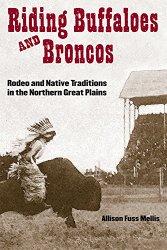$29.95
$20.95
(SAVE Now!)
as of 11/24/2024 (Details)
After his remarkable eight-second ride at the 1996 Indian National Finals Rodeo, an elated American Indian world champion bullrider from Pine Ridge, South Dakota, threw his cowboy hat in the air. Everyone in the almost exclusively Indian audience erupted in applause. Over the course of the twentieth century, rodeos have joined tribal fairs and powwows as events where American Indians gather to celebrate community and equestrian competition. In Riding Buffaloes and Broncos, Allison Fuss Mellis reveals how northern Plains Indians have used rodeo to strengthen tribal and intertribal ties and Native solidarity.In the late nineteenth century, Indian agents outlawed most traditional Native gatherings but allowed rodeo, which they viewed as a means to assimilate Indians into white culture. Mistakenly, they treated rodeo as nothing more than a demonstration of ranching skills. Yet through selective adaptation, northern Plains horsemen and audiences used rodeo to sidestep federally sanctioned acculturation. Rodeo now enabled Indians to reinforce their commitment to the very Native values--a reverence for horses, family, community, generosity, and competition--that federal agencies sought to destroy.Mellis has mined archival sources and interviewed American Indian rodeo participants and spectators throughout the northern Great Plains, Southwest, and Canada, including Crow, Northern Cheyenne, and Lakota reservations. The book features numerous photographs of Indian rodeos from the nineteenth and twentieth centuries and maps illustrating the all-Indian rodeo circuit in the United States and Canada.
Technical Details
- Used Book in Good Condition
